Page 226 of 539
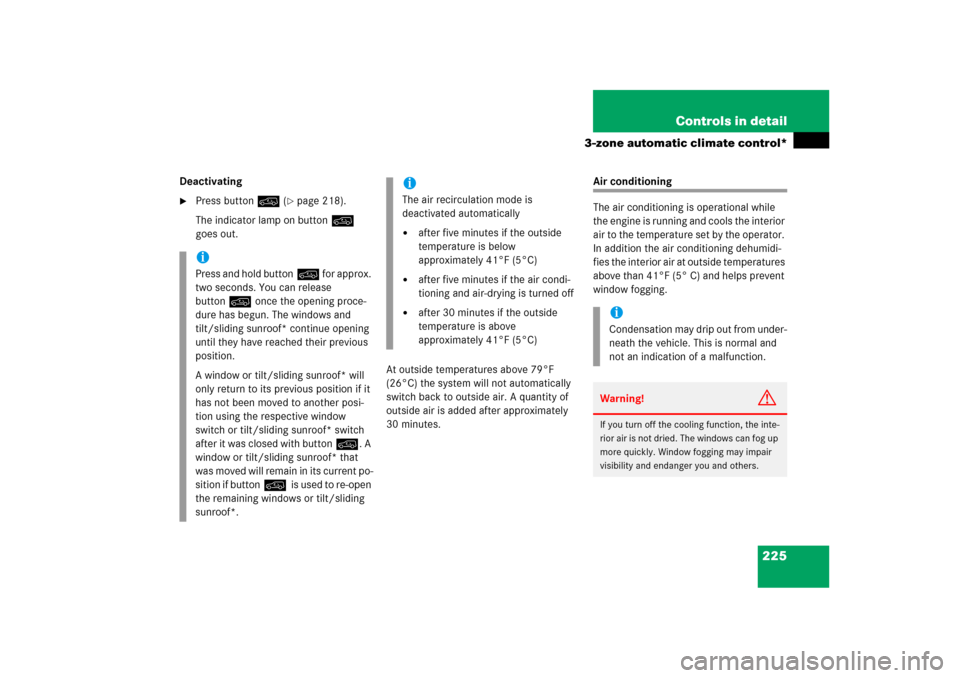
225 Controls in detail
3-zone automatic climate control*
Deactivating�
Press button: (
�page 218).
The indicator lamp on button:
goes out.
At outside temperatures above 79°F
(26°C) the system will not automatically
switch back to outside air. A quantity of
outside air is added after approximately
30 minutes.
Air conditioning
The air conditioning is operational while
the engine is running and cools the interior
air to the temperature set by the operator.
In addition the air conditioning dehumidi-
fies the interior air at outside temperatures
above than 41°F (5° C) and helps prevent
window fogging.
iPress and hold button: for approx.
two seconds. You can release
button: once the opening proce-
dure has begun. The windows and
tilt/sliding sunroof* continue opening
until they have reached their previous
position.
A window or tilt/sliding sunroof* will
only return to its previous position if it
has not been moved to another posi-
tion using the respective window
switch or tilt/sliding sunroof* switch
after it was closed with button:. A
window or tilt/sliding sunroof* that
was moved will remain in its current po-
sition if button: is used to re-open
the remaining windows or tilt/sliding
sunroof*.
iThe air recirculation mode is
deactivated automatically�
after five minutes if the outside
temperature is below
approximately 41°F (5°C)
�
after five minutes if the air condi-
tioning and air-drying is turned off
�
after 30 minutes if the outside
temperature is above
approximately 41°F (5°C)
iCondensation may drip out from under-
neath the vehicle. This is normal and
not an indication of a malfunction.Warning!
G
If you turn off the cooling function, the inte-
rior air is not dried. The windows can fog up
more quickly. Window fogging may impair
visibility and endanger you and others.
Page 227 of 539
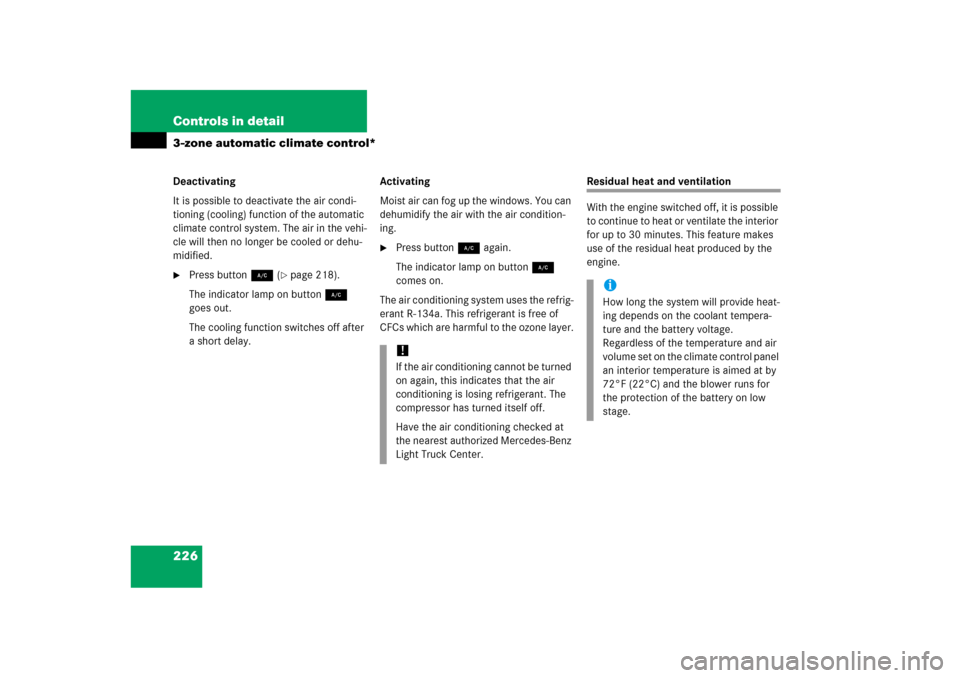
226 Controls in detail3-zone automatic climate control*Deactivating
It is possible to deactivate the air condi-
tioning (cooling) function of the automatic
climate control system. The air in the vehi-
cle will then no longer be cooled or dehu-
midified.�
Press button2 (
�page 218).
The indicator lamp on button2
goes out.
The cooling function switches off after
a short delay.Activating
Moist air can fog up the windows. You can
dehumidify the air with the air condition-
ing.
�
Press button2 again.
The indicator lamp on button2
comes on.
The air conditioning system uses the refrig-
erant R-134a. This refrigerant is free of
CFCs which are harmful to the ozone layer.
Residual heat and ventilation
With the engine switched off, it is possible
to continue to heat or ventilate the interior
for up to 30 minutes. This feature makes
use of the residual heat produced by the
engine.
!If the air conditioning cannot be turned
on again, this indicates that the air
conditioning is losing refrigerant. The
compressor has turned itself off.
Have the air conditioning checked at
the nearest authorized Mercedes-Benz
Light Truck Center.
iHow long the system will provide heat-
ing depends on the coolant tempera-
ture and the battery voltage.
Regardless of the temperature and air
volume set on the climate control panel
an interior temperature is aimed at by
72°F (22°C) and the blower runs for
the protection of the battery on low
stage.
Page 228 of 539
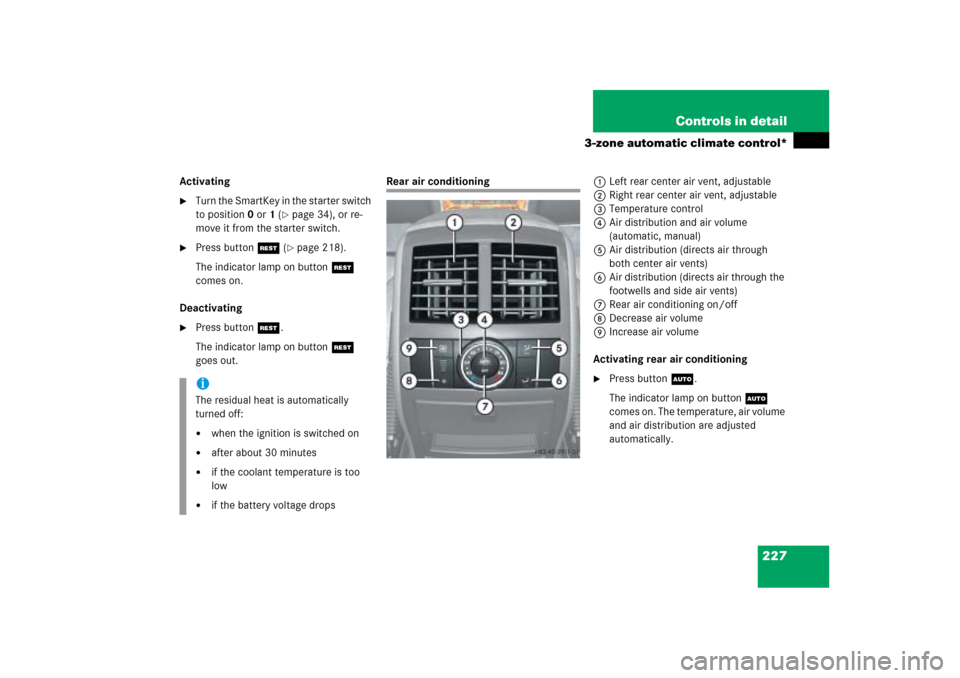
227 Controls in detail
3-zone automatic climate control*
Activating�
Turn the SmartKey in the starter switch
to position0 or1 (
�page 34), or re-
move it from the starter switch.
�
Press buttonT (
�page 218).
The indicator lamp on buttonT
comes on.
Deactivating
�
Press buttonT.
The indicator lamp on buttonT
goes out.
Rear air conditioning1Left rear center air vent, adjustable
2Right rear center air vent, adjustable
3Temperature control
4Air distribution and air volume
(automatic, manual)
5Air distribution (directs air through
both center air vents)
6Air distribution (directs air through the
footwells and side air vents)
7Rear air conditioning on/off
8Decrease air volume
9Increase air volume
Activating rear air conditioning
�
Press buttonU.
The indicator lamp on buttonU
comes on. The temperature, air volume
and air distribution are adjusted
automatically.
iThe residual heat is automatically
turned off:�
when the ignition is switched on
�
after about 30 minutes
�
if the coolant temperature is too
low
�
if the battery voltage drops
Page 229 of 539
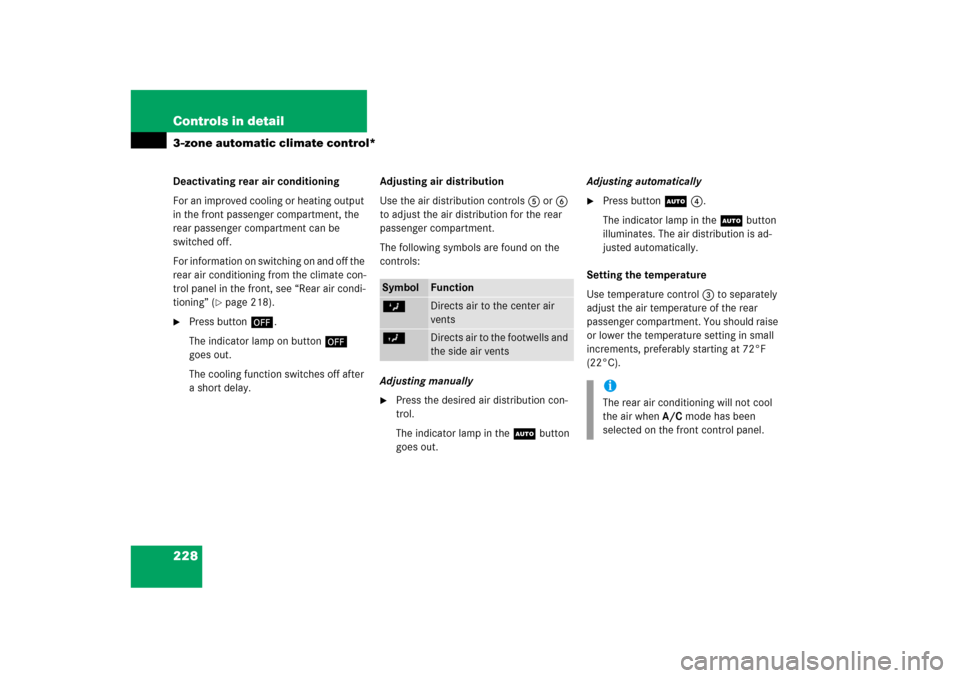
228 Controls in detail3-zone automatic climate control*Deactivating rear air conditioning
For an improved cooling or heating output
in the front passenger compartment, the
rear passenger compartment can be
switched off.
For information on switching on and off the
rear air conditioning from the climate con-
trol panel in the front, see “Rear air condi-
tioning” (
�page 218).
�
Press button´.
The indicator lamp on button´
goes out.
The cooling function switches off after
a short delay.Adjusting air distribution
Use the air distribution controls5 or6
to adjust the air distribution for the rear
passenger compartment.
The following symbols are found on the
controls:
Adjusting manually
�
Press the desired air distribution con-
trol.
The indicator lamp in the Ubutton
goes out.Adjusting automatically
�
Press buttonU4.
The indicator lamp in the Ubutton
illuminates. The air distribution is ad-
justed automatically.
Setting the temperature
Use temperature control3 to separately
adjust the air temperature of the rear
passenger compartment. You should raise
or lower the temperature setting in small
increments, preferably starting at 72°F
(22°C).
Symbol
Function
Z
Directs air to the center air
vents
Y
Directs air to the footwells and
the side air vents
iThe rear air conditioning will not cool
the air when A/C mode has been
selected on the front control panel.
Page 230 of 539
229 Controls in detail
3-zone automatic climate control*
Increasing/decreasing the temperature�
Turn the temperature control3 slight-
ly left or right until the desired temper-
ature is selected.
The rear air conditioning will corre-
spondingly adjust the interior air tem-
perature for the rear passenger
compartment.
Adjusting air volume
�
Press� to decrease orQ to in-
crease air volume to the desired level.
Page 319 of 539
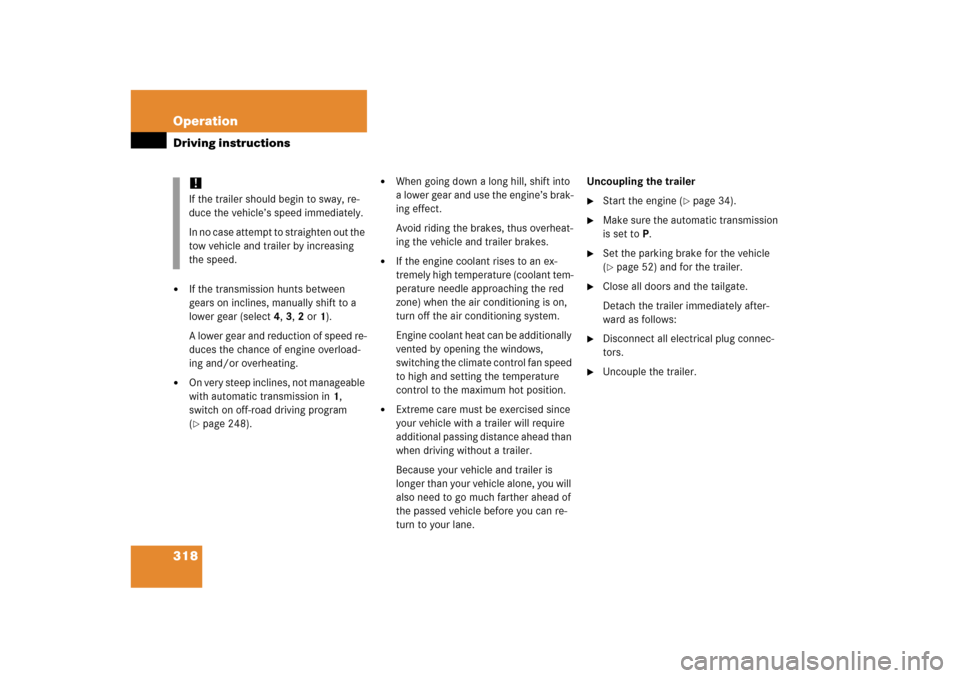
318 OperationDriving instructions�
If the transmission hunts between
gears on inclines, manually shift to a
lower gear (select 4, 3, 2 or 1).
A lower gear and reduction of speed re-
duces the chance of engine overload-
ing and/or overheating.
�
On very steep inclines, not manageable
with automatic transmission in1,
switch on off-road driving program
(�page 248).
�
When going down a long hill, shift into
a lower gear and use the engine’s brak-
ing effect.
Avoid riding the brakes, thus overheat-
ing the vehicle and trailer brakes.
�
If the engine coolant rises to an ex-
tremely high temperature (coolant tem-
perature needle approaching the red
zone) when the air conditioning is on,
turn off the air conditioning system.
Engine coolant heat can be additionally
vented by opening the windows,
switching the climate control fan speed
to high and setting the temperature
control to the maximum hot position.
�
Extreme care must be exercised since
your vehicle with a trailer will require
additional passing distance ahead than
when driving without a trailer.
Because your vehicle and trailer is
longer than your vehicle alone, you will
also need to go much farther ahead of
the passed vehicle before you can re-
turn to your lane.Uncoupling the trailer
�
Start the engine (
�page 34).
�
Make sure the automatic transmission
is set toP.
�
Set the parking brake for the vehicle
(�page 52) and for the trailer.
�
Close all doors and the tailgate.
Detach the trailer immediately after-
ward as follows:
�
Disconnect all electrical plug connec-
tors.
�
Uncouple the trailer.
!If the trailer should begin to sway, re-
duce the vehicle’s speed immediately.
In no case attempt to straighten out the
tow vehicle and trailer by increasing
the speed.
Page 366 of 539

365 Operation
Tires and wheels
Tire and loading terminology
Accessory weight
The combined weight (in excess of those
standard items which may be replaced) of
automatic transmission, power steering,
power brakes, power windows, power
seats, radio, and heater, to the extent that
these items are available as
factory-installed equipment (whether
installed or not).
Air pressure
The amount of air inside the tire pressing
outward on each square inch of the tire.
Air pressure is expressed in pounds per
square inch (psi), or kilopascal (kPa) or
bars.
Aspect ratio
Dimensional relationship between tire
section height and section width
expressed in percentage.Bar
Another metric unit for air pressure. There
are 14.5038 pounds per square inch (psi)
to 1 bar; there are 100 kilopascals (kPa)
to 1 bar.
Bead
The tire bead contains steel wires wrapped
by steel cords that hold the tire onto the
rim.
Cold tire inflation pressure
Tire inflation pressure when your vehicle
has been sitting for at least three hours or
driven no more than one mile (1.6 km).
Curb weight
The weight of a motor vehicle with stan-
dard equipment including the maximum
capacity of fuel, oil, and coolant, and, if so
equipped, air conditioning and additional
optional equipment, but without passen-
gers and cargo.DOT (D
epartment o
f T
ransportation)
A tire branding symbol which denotes the
tire meets requirements of the
U.S. Department of Transportation.
GAWR (G
ross A
xle W
eight R
ating)
The GAWR is the maximum permissible
axle weight. The gross vehicle weight on
each axle must never exceed the GAWR for
the front and rear axle indicated on the
certification label located on the driver’s
door B-pillar.
GTW (G
ross T
railer W
eight)
The GTW is the weight of the trailer plus
the weight of all cargo, equipment, luggage
etc. loaded on the trailer.
Page 486 of 539
485 Technical data
Layout of poly-V-belt drive
�Layout of poly-V-belt drive
ML 350
1Idler pulley
2Idler pulley
3Automatic belt tensioner
4Power steering pump
5Air conditioning compressor
6Crankshaft
7Coolant pump
8Generator (alternator)
ML 500
1Automatic belt tensioner
2Power steering pump
3Air conditioning compressor
4Crankshaft
5Coolant pump
6Generator (alternator)
7Idler pulley